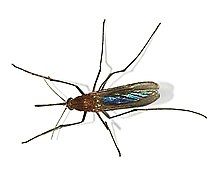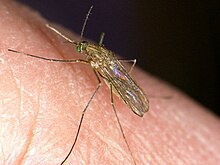Culex pipiens
| Culex pipiens | |
|---|---|

| |
| Scientific classification | |
| Kingdom: | |
| Phylum: | |
| Class: | |
| Order: | |
| Family: | |
| Genus: | |
| Subgenus: | |
| Species: | C. pipiens
|
| Binomial name | |
| Culex pipiens | |
Culex pipiens (the common house mosquito or northern house mosquito) is a species of blood-feeding mosquito of the family Culicidae. It is a vector of some diseases, such as Japanese encephalitis, meningitis, and urticaria. In the US and parts of Europe, it can spread West Nile virus, and in Emilia-Romagna, Italy, it has been demonstrated to be a vector of Usutu virus.[1]
Distribution
It occurs in the following countries: Argentina, Austria, Bosnia and Herzegovina, Bulgaria, Canada, Croatia, Cyprus, Czech Republic, Egypt, France, Germany, Greece, Hungary, Iran, Ireland, Israel, Italy, Japan, Jordan, Korea (South), Latvia, Lebanon, Lithuania, Luxembourg, Morocco, Pakistan, Poland, Portugal, Romania, Russia, Saudi Arabia, Serbia, Slovakia, Spain, Sweden, Tajikistan, Tunisia, Turkey, the United Kingdom, the United States, Uruguay, the Netherlands and Montenegro.[2][3]
Description

Body length varies from three to seven millimeters.
Ecology
Both males and females feed on various sugar sources, such as nectar, honeydew and juices from fruits.
Only females feed on blood, and will do so preferentially, over sugar, when they have mated. Blood provides proteins essential to the development of their eggs. Their primary blood meal hosts are considered to be birds, but they will feed on humans and other mammals.
Population control
Culex pipiens can be a vector of many diseases that are transmitted to hosts when the mosquito bites them. It has been found that by using the Wolbachia infection to intentionally infect this species, their reproduction can be suppressed by inserting genes through the infection that restrict their ability to reproduce. [4] This has also proved successful in the related Aedes albopictus species, also known as the Asian Tiger mosquito.
Subspecies
Culex pipiens molestus lives in the London Underground and other underground railways. The more common Culex pipiens subspecies observed above ground is sometimes referred to as Culex pipiens pipiens.
References
- ^ Calzolari M, Gaibani P, Bellini R, Defilippo F, Pierro A, Albieri A, et al. (2012) Mosquito, Bird and Human Surveillance of West Nile and Usutu Viruses in Emilia-Romagna Region (Italy) in 2010. PLoS ONE 7(5): e38058; http://journals.plos.org/plosone/article?id=10.1371/journal.pone.0038058.
- ^ KIM, Heung Chul, Richard C. WILKERSON, James E. PECOR, Won Ja LEE, John S. LEE , Monica L. O' Guinn and Terry A. KLEIN. 2005. New Records and Reference Collection of Mosquitoes (Diptera: Culicidae) on Jeju Island, Republic of Korea. Entomological Research, 35(1): 55-66; http://www.mosquitocatalog.org/files/pdfs/wr388.pdf.
- ^ Photos Culex pipiens TaxonConcept Knowledge Base University of Wisconsin
- ^ Xi, Z; Dean, JL; Khoo, C; Dobson, SL (August 2005). "Generation of a novel Wolbachia infection in Aedes albopictus (Asian tiger mosquito) via embryonic microinjection". PubMed. 35 (8): 903–910.
